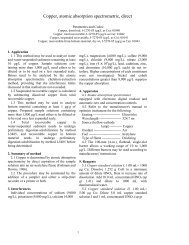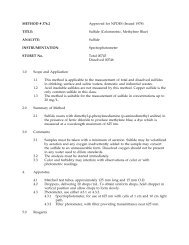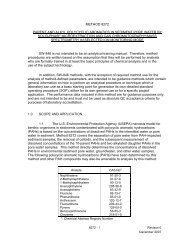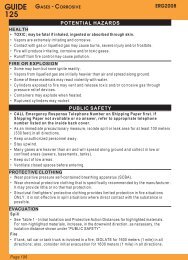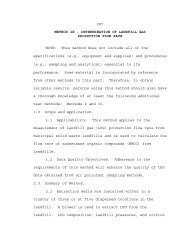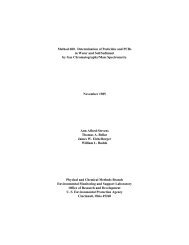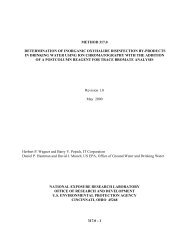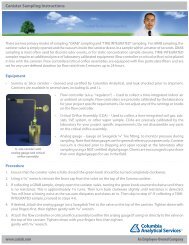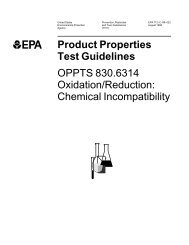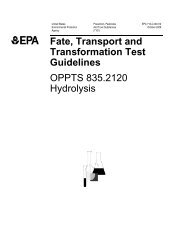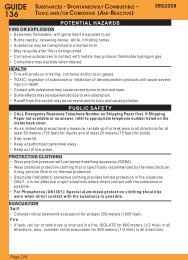View Actual EPA Method 8081A (PDF File)
View Actual EPA Method 8081A (PDF File)
View Actual EPA Method 8081A (PDF File)
You also want an ePaper? Increase the reach of your titles
YUMPU automatically turns print PDFs into web optimized ePapers that Google loves.
Construct a similar baseline in the sample chromatogram, measure the area, and usethe calibration factor to calculate the concentration in the sample.7.6.2.2 The GC pattern of a Chlordane residue in a sample may differconsiderably from that of the Technical Chlordane standard. In such instances, it maynot be practical to relate a sample chromatogram back to the pesticide active ingredientTechnical Chlordane. Therefore, depending on the objectives of the analysis, the analystmay choose to report the sum of all the identifiable Chlordane components as “Chlordane(n.o.s.)” under the CAS number 57-74-9.7.6.2.3 The third option is to quantitate the peaks of "-Chlordane, (-Chlordane,and Heptachlor separately against the appropriate reference materials, and report theseindividual components under their respective CAS numbers.7.6.2.4 To measure the total area of the Chlordane chromatogram, inject anamount of a Technical Chlordane standard which will produce a chromatogram in whichthe major peaks are approximately the same size as those in the samplechromatograms.7.6.3 Hexachlorocyclohexane - Hexachlorocyclohexane is also known as BHC, fromthe former name, benzene hexachloride. Technical grade BHC is a cream-colored amorphoussolid with a very characteristic musty odor. It consists of a mixture of six chemically distinctisomers and one or more heptachlorocyclohexanes and octachlorocyclohexanes. CommercialBHC preparations may show a wide variance in the percentage of individual isomers present.Quantitate each isomer (", $, (, and *) separately against a standard of the respective pureisomer.7.6.4 DDT - Technical DDT consists primarily of a mixture of 4,4'-DDT (approximately75%) and 2,4'-DDT (approximately 25%). As DDT weathers, 4,4'-DDE, 2,4'-DDE, 4,4'-DDD,and 2,4'-DDD are formed. Since the 4,4'-isomers of DDT, DDE, and DDD predominate in theenvironment, these are the isomers normally regulated by <strong>EPA</strong>. Therefore, sample extractsshould be quantitated against standards of the respective pure isomers of 4,4'-DDT, 4,4'-DDE,and 4,4'-DDD.7.7 GC/MS confirmation may be used in conjunction with either single-column or dual-columnanalysis if the concentration is sufficient for detection by GC/MS.7.7.1 Full-scan GC/MS will normally require a concentration of approximately 10 ng/µLin the final extract for each single-component compound. Ion trap or selected ion monitoringwill normally require a concentration of approximately 1 ng/µL.7.7.2 The GC/MS must be calibrated for the specific target pesticides when it is usedfor quantitative analysis.7.7.3 GC/MS may not be used for confirmation when concentrations are below 1 ng/µLin the extract.7.7.4 GC/MS confirmation should be accomplished by analyzing the same extract thatis used for GC/ECD analysis and the extract of the associated method blank.7.7.5 The base/neutral/acid extract and the associated blank may be used for GC/MSconfirmation if the surrogates and internal standards do not interfere and if it is demonstratedCD-ROM <strong>8081A</strong> - 19 Revision 1December 1996



